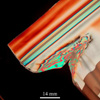Micrograph Library
Browse the libraryAdvanced searchSystemsCompositionsTechniquesKeywordsPhase diagramsHelpPreferencesAbout the micrograph libraryTerms of useContribute micrographs!FeedbackLinksCredits Print this page

Full Record for Micrograph 573

[88 KB]
View micrograph
.. in new window
View micrograph and record
.. in new window
You can also view and download the micrographs on Flickr
- Micrograph no
- 573
- Brief description
- Birefringence in a film of polyethylene
- Keywords
- alignment, birefringence
 , extrusion
, extrusion  , film, polyethylene (PE), polymer
, film, polyethylene (PE), polymer  , polythene
, polythene - Categories
- Polymer
- System
- Low density polyethylene (LDPE)
- Composition
- Not specified
- Standard codes
- Reaction
- Processing
- This film is made by biaxially stretching heated material during the extrusion process.
- Applications
- Polyethylene is the most common polymer. Low density polyethylene (LDPE) is widely used as a film for packaging
- Sample preparation
- The packet has been torn open, to demonstrate residual chain alignement around the tear
- Technique
- Cross-polarised light microscopy
- Length bar
- 14 mm
- Further information
- The colours in the image are the result of birefringence and relate to the residual stress in the film. The colour is generally uniform (with some contrast where an additional thickness of film exists or where wrinkling has resulted in a different apparent thickness). This is indicative of both a uniform film thickness and of the uniformity of the drawing process used to make the film. In the region of the tear, however, the colours indicate strain-induced orientation: because the material is above the glass transition temperature of PE (-30 deg C) chain sliding occurs readily under and applied stress and the molecules become aligned along the tensile axis. The strain is permanent and does not relax when the stress is removed. However, if the material were annealed at ~100 deg C, it would relax towards its original configuration, and uniform colour would again be observed.
- Contributor
- J A Curran
- Organisation
- Department of Materials Science and Metallurgy, University of Cambridge
- Date
- 03/10/02
- Licence for re-use
 Attribution-NonCommercial-ShareAlike 4.0 International
Attribution-NonCommercial-ShareAlike 4.0 International

